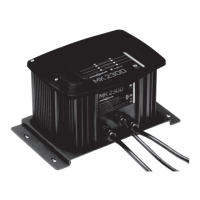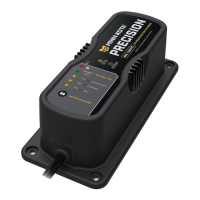c) Wear complete eye protection and clothing protection. Avoid touching eyes while working near battery.
d) If battery acid contacts skin or clothing, wash immediately with soap and water. If acid enters eye, immediately flush eye with running cold
water for at least 10 minutes and get medical attention immediately.
e) Never smoke or allow a spark or flame in vicinity of battery, engine, motor or other flammable or explosive equipment.
f) Be extra cautious to reduce risk of dropping a metal tool onto the battery or across the battery terminals. It might spark or short circuit the bat-
tery or other electrical component that may cause an explosion.
g) Remove personal metal items such as rings, bracelets, necklaces, and watches when working with a lead acid battery. A lead acid battery
can produce a short circuit current high enough to weld such items, causing severe burns.
h) Use the Minn Kota battery charger for charging and maintaining FLOODED LEAD-ACID, MAINTENANCE FREE, GEL CELL, AND AGM /
STARVED ELECTROLYTE batteries only. It is not intended to supply power to low voltage electrical systems other than for charging and
maintaining batteries. Do not use the charger for charging dry-cell batteries that are commonly used with home appliances. These batteries
may burst and cause injury to persons and damage to property.
i) NEVER charge a frozen battery.
3) PREPARING TO CHARGE
a) If necessary to remove battery from boat or vehicle to charge or maintain, always remove grounded terminal from battery first (if applicable).
Make sure all accessories in the boat or vehicle are off, so as not to cause an arc.
b) Be sure area around battery is well ventilated while battery is being charged or maintained.
c) Clean battery terminals. Be careful to keep corrosion from coming in contact with eyes.
d) Add distilled water in each cell until battery acid reaches level specified by battery manufacturer. Do not overfill. For a battery without remov-
able cell caps, such as valve regulated lead acid batteries, carefully follow manufacturer’s recharging instructions.
e) Study all battery manufacturers’ specific precautions while charging and for recommended rates of charge.
4) CHARGER LOCATION AND MOUNTING
a) Locate charger as far away from battery as the dc cables permit.
b) Never place charger above battery being charged; gases from battery will corrode and damage charger.
c) Never allow battery acid to drip on charger when reading electrolyte specific gravity or filling battery.
d) Do not operate charger in a closed-in area or restrict ventilation in any way.
e) Do not set a battery on top of charger.
f) Do not mount the charger below the waterline of the boat or directly adjacent to fuel tanks.
g) Each DC output cord is six feet long. Make sure that all DC output cords can reach the batteries and that the AC power cord can reach a
power source. When using an extension cord, make the AC connection to the charger outside of the battery compartment as far away as
practical to reduce the risk of a spark igniting gasses in the compartment.
h) Each output cord is equipped with a temperature sensor. By monitoring external temperature, the battery charger adjusts the charging profile
of the battery to assure full charge without overcharging or undercharging the battery. Attempting to shorten the output wires could damage
the temperature sensor and affect the charger output.
i) If the DC battery leads are not long enough, they may be lengthened by splicing and soldering 12 AWG (minimum) wire. Each splice should
be covered with dual wall adhesive lined heat shrink tubing to protect the joint from corroding. The splice should be made between the
fork in the output cable and the fuse holder. The fuse holder should always remain within 7” of the battery terminals. The maximum exten-
sion length is 15 feet. You may contact the Minn Kota Service Department with any questions. Do not splice the AC power cord, as this
voids the three year Limited Warranty.
3

